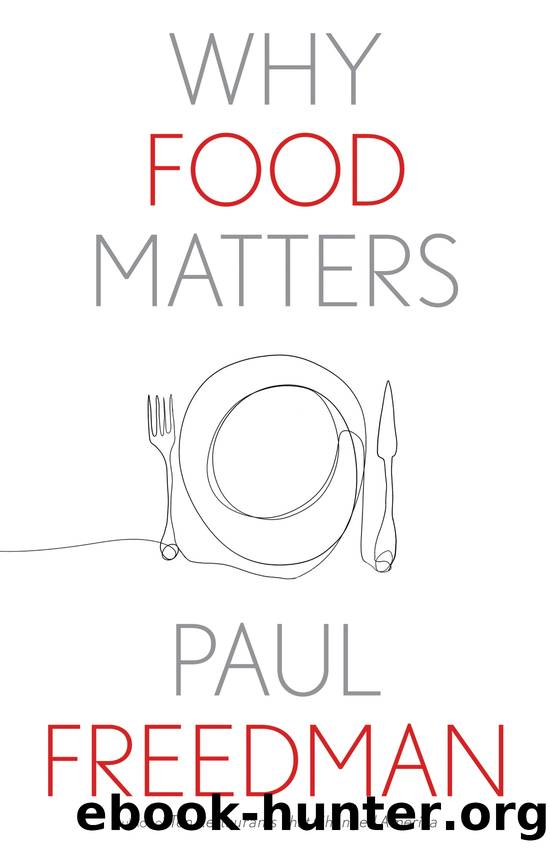Why Food Matters by Paul Freedman

Author:Paul Freedman
Language: eng
Format: epub
ISBN: 9780300253771
Publisher: Yale University Press
7
race
Whatâs the difference between soul and southern food? I get asked that question a lot.
âADRIAN MILLER, SOUL FOOD
Ethnicity, income, and gender affect what people eat. The notion that vegetarianism is feminine, for example, or that only Swedes and Norwegians like lutefisk (gelatinous fermented fish) amount to more than odd epiphenomena. They are part of the personal and collective orientation around food described earlier. This chapter looks at race, another way of structuring the everyday significance of food in history. What follows considers African Americans as the authors and agents of food culture.
The enslavement of Africans and their transport to the Americas had varying culinary effects. Discussing the food of the British North American colonies, the food historian James E. McWilliams identified regions whose distinct cuisines were determined less than one would expect by climate or environment and more by the extent of slavery and the type of agricultural economy. The Caribbean islands, the mainland South, the mid-Atlantic, and New England differed as to the proportion of the enslaved population and, as a result, the nature of their culinary evolutions.
In the seventeenth and the first half of the eighteenth century, British entrepreneurs and the government made far more money from the West Indies than from any other part of the expanding empire. By the late seventeenth century, islands like Barbados and Antigua were given over to sugar cultivation and more than seventy-five percent of their inhabitants were enslaved people from Africa. The sugar plantation owners were not interested in making a permanent home in what they considered an unhealthful climate, any more than American oil technicians today expect to put down roots in Angola or Saudi Arabia. Planters intended to make as much money as possible as quickly as they could and return home in triumph to their native territory.
Although relentless in their pursuit of profit, planters could not simply starve the men and women they enslaved. The workers had to be fed, and it proved more economical and less troublesome to give the slaves land to raise their own food than to spend money to provide them with expensive biscuits, dried fish, and salt meat from Europe. As long as the slaves were going to be allowed to fish, catch animals, and cultivate edible plants, their masters figured they might as well eat what the slaves were cooking. Not only were imported hardtack and salt pork costly, they often arrived in poor condition after a long voyage.
Not surprisingly then, the cuisine of the Caribbean is the closest to Africa of any in North America. The slave trade brought over products of African origin such as okra, sorghum, watermelon, and yams, as well as staples originally from Asia such as bananas, plantains, and rice that were already circulating in Africa. Enslaved cooks used American starches such as corn and cassava and adapted Native American methods for cooking turtles and fish. Some New World items like cassava eventually became more important in Africa through commerce with the New World than they had been in the Americas.
Download
This site does not store any files on its server. We only index and link to content provided by other sites. Please contact the content providers to delete copyright contents if any and email us, we'll remove relevant links or contents immediately.
A Court of Wings and Ruin by Sarah J. Maas(7733)
The Death of the Heart by Elizabeth Bowen(3580)
The Sprouting Book by Ann Wigmore(3562)
Better Homes and Gardens New Cookbook by Better Homes & Gardens(3550)
BraveTart by Stella Parks(3417)
Salt, Fat, Acid, Heat: Mastering the Elements of Good Cooking by Nosrat Samin(3122)
Sauces by James Peterson(3071)
Kitchen confidential by Anthony Bourdain(3051)
The Bread Bible by Rose Levy Beranbaum(3040)
Classic by Mary Berry(2979)
Solo Food by Janneke Vreugdenhil(2949)
Ottolenghi - The Cookbook by Yotam Ottolenghi(2898)
Martha Stewart's Baking Handbook by Martha Stewart(2828)
Day by Elie Wiesel(2752)
Betty Crocker's Good and Easy Cook Book by Betty Crocker(2700)
The Plant Paradox by Dr. Steven R. Gundry M.D(2583)
My Pantry by Alice Waters(2581)
The Kitchen Counter Cooking School by Kathleen Flinn(2500)
Hot Sauce Nation by Denver Nicks(2466)
